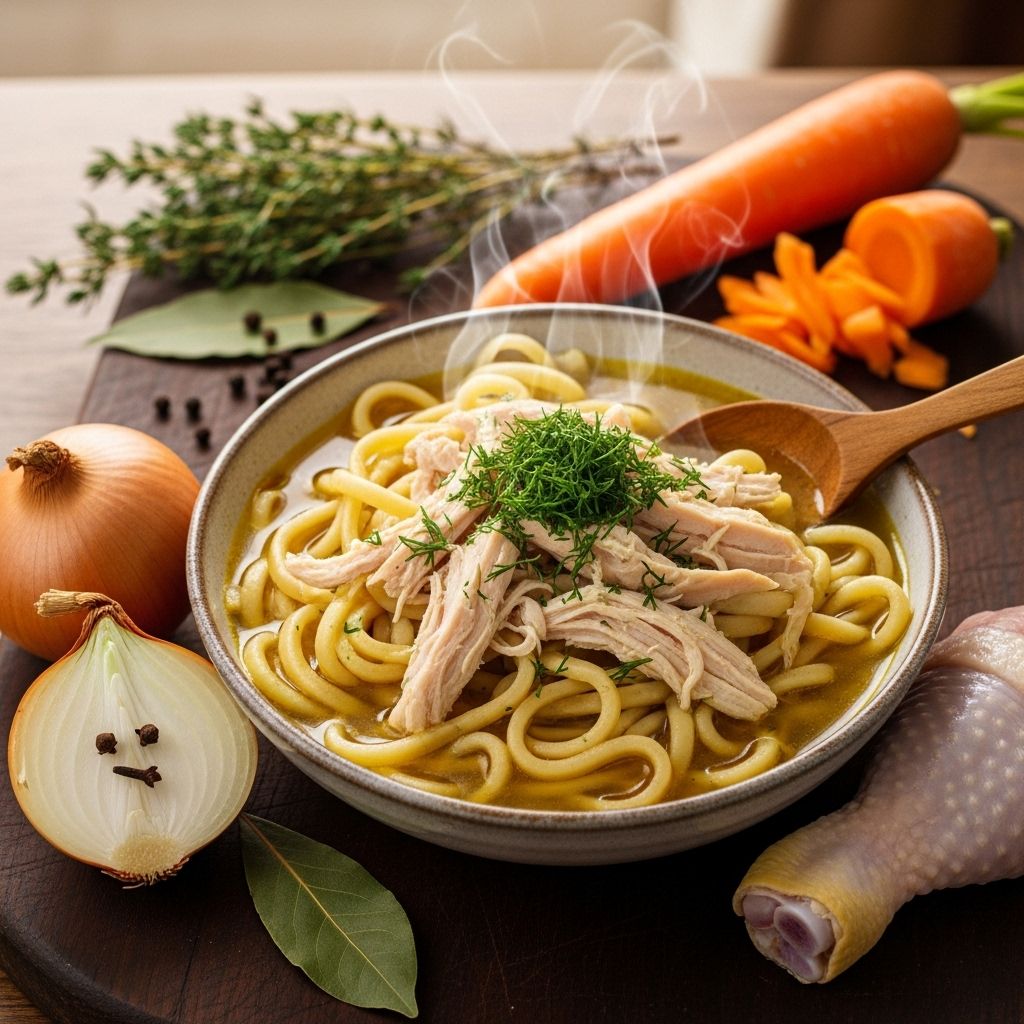Homemade Chicken and Noodles
Savor the warmth of shredded chicken paired with tender noodles and vibrant veggies.

Introduction to Homemade Chicken and Noodles
Homemade chicken and noodles is a classic comfort food dish that has been a staple in many households for generations. Its simplicity, combined with the rich, satisfying flavors it offers, makes it a perfect meal for both casual gatherings and special occasions. In this article, we will delve into the details of preparing this traditional dish, highlighting the steps involved and the key ingredients needed.
Key Ingredients
To make homemade chicken and noodles, you will need the following essential ingredients:
- Chicken: A whole fryer chicken, cut up, is the base of this dish.
- Veggies: Carrots, celery, and an onion add depth and texture to the broth.
- Herbs and Spices: Thyme, turmeric, and parsley flakes are used to flavor the dish.
- Noodles: Frozen egg noodles are a crucial component, providing a homey feel to the dish.
- Flour and Water: Used to thicken the broth and create a hearty consistency.
Step-by-Step Guide to Preparing Homemade Chicken and Noodles
Step 1: Simmering the Chicken
Begin by covering the chicken pieces in about 4 quarts of water in a large pot. Bring the water to a boil, then reduce the heat to low and simmer for 30 minutes. This step helps to extract the rich flavors from the chicken into the broth.
Step 2: Removing and Shredding the Chicken
After the initial simmering, remove the chicken from the pot using a slotted spoon. Use two forks to pull the meat off the bones, shredding it slightly in the process. Set the shredded chicken aside. Return the bones to the pot and continue simmering for another 45 minutes to enrich the broth further.
Step 3: Adding Vegetables and Spices
Once the extended simmering is complete, remove the bones from the pot and add diced carrots, celery, and onions. Follow this with the addition of thyme, turmeric, and parsley flakes. Stir well to combine and simmer for about 10 minutes to allow the flavors to meld.
Step 4: Adding Noodles and Thickening the Broth
Increase the heat and add frozen egg noodles to the pot. Cook for 8 to 10 minutes, or until the noodles are tender. In a small bowl, mix flour with a little water until smooth. Stir this mixture into the pot to thicken the broth slightly, creating a more stew-like consistency. Simmer for an additional 5 minutes to ensure the broth is thickened to your liking.
Benefits and Variations of Homemade Chicken and Noodles
This dish is not only delicious but also versatile. It can be served as a main course or as a side dish, depending on your preference. For a creamier version, consider adding a splash of half-and-half or using a roux to thicken the broth further. Additionally, you can customize the dish by adding other vegetables or spices to suit your taste.
Frequently Asked Questions (FAQs)
Q: What type of chicken is best for homemade chicken and noodles?
A: A whole fryer chicken is ideal for this recipe, as it provides both the meat and a rich broth.
Q: How do I thicken the broth if it remains too thin?
A: You can thicken the broth by adding more flour mixed with water or by using cornstarch. Adjust the amount according to your desired consistency.
Q: Can I use fresh herbs instead of dried parsley flakes?
A: While fresh herbs can be used, dried parsley flakes are often preferred for this recipe due to their convenience and longer shelf life.
Conclusion
Homemade chicken and noodles is a recipe that embodies the warmth and comfort of home cooking. With its simple ingredients and straightforward preparation steps, it is a dish that can be enjoyed by people of all ages and backgrounds. Whether you are looking for a hearty meal to enjoy on a chilly evening or a comforting dish for a family gathering, this recipe is sure to satisfy.
References
Read full bio of medha deb












